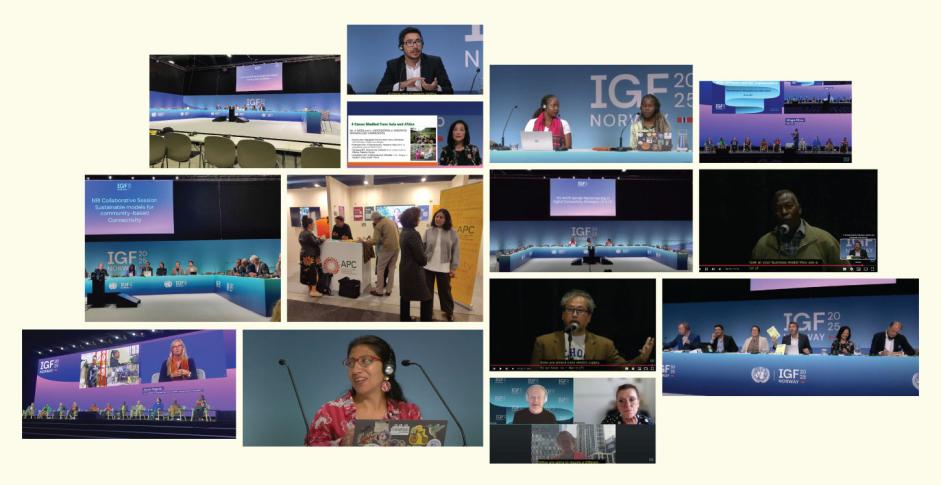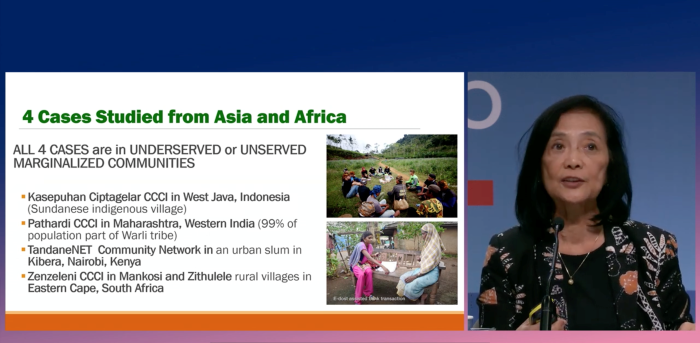
The World Summit on the Information Society (WSIS) is currently undergoing its 20-year review, with a high-level meeting scheduled to take place in Geneva from 7 to 11 July. This event will bring together stakeholders from across the globe, just a few weeks after the 20th edition of the Internet Governance Forum (IGF). We see with both events how community-centred connectivity initiatives (CCCIs) are gaining visibility in the ongoing global dialogue, offering alternative approaches to access and connectivity for marginalised communities, and advancing the pursuit of meaningful and sustainable models.
The IGF featured key sessions that amplified voices from diverse stakeholders. A central theme was the continued challenge of integrating a gender perspective into connectivity efforts. At the same time, a strategic and emerging issue for the sustainability of CCCIs came to the fore: the need for supportive and tailored financing mechanisms for all actors within the connectivity ecosystem.
The upcoming WSIS+20 event will offer a critical opportunity to continue this conversation, reviewing the commitments and progress made since the initial WSIS processes in 2003 and 2005. With recent dialogues from IGF still resonating, the Local Networks Initiative is preparing to engage in the WSIS+20 high-level event. There will be a focus on CCCIs during sessions and at the booth that APC, Rhizomatica and REDES A.C. are hosting at the event. More information about the agenda can be found here.
A key agenda for an enabling environment
During the annual session of the UN Commission on Science and Technology for Development, earlier this year, APC presented a policy brief outlining a six-pillar plan to diversify access markets. This document, which will be under the spotlight during WSIS+20, underscores the broader social mission of community-centred initiatives. As connectivity providers, such initiatives promote inclusive participation, build digital skills and foster locally relevant digital content – demonstrating that access is about much more than infrastructure.
The tenets of the six-pillar strategy focus on the value of a diversified ecosystem, reducing regulatory requirements for CCCIs, establishing innovative financing and investment models, adopting mechanisms to share spectrum, ensuring affordable access to backhaul networks, raising awareness and building capacity.
“The WSIS+20 review offers a vital opportunity to strengthen the recently adopted Global Digital Compact (GDC) commitments and update public policies that enable financial mechanisms to expand these proven models,” the brief concludes. Here we share some voices agreeing that this is a critical step towards a people-centred information society.
A diverse and inclusive ecosystem
One standout session during this year’s IGF, Innovative Regulatory Strategies for Digital Inclusion, introduced vivid metaphors from advocates pushing for inclusive policies, regulation and financing models for those connecting underserved communities. Tech expert Steve Song referred to the “jar of stones”, illustrating the need to include smaller actors to fill the connectivity gaps that large operators, the “big stones”, overlook.
Building on this metaphor, Carlos Rey-Moreno emphasised three priorities: recognition, capacity building and financial support for diverse community actors. “There’s still a mindset that only large, traditional operators can solve connectivity problems,” Rey-Moreno said. “We need to enable diverse ways of engaging, building and using the internet. The ecosystem is ready. The willingness is there. But the enabling environment is not.”
Financing for community networks emerged as a key theme at IGF 2025 – and is likely to be carried forward to WSIS+20. A growing coalition of experts, funders and grassroots leaders is advocating for financial models tailored for small, community-led projects.
“To scale community-centred connectivity in rural and marginalised areas, we need a more diversified ecosystem that recognises there’s no one-size-fits-all approach. Communities should be able to self-provide infrastructure, and they need support to do so,” said APC’s Josephine Miliza.
She stressed the need for innovative financing: “As small-scale operators, these initiatives need funding mechanisms that reflect community realities. Public funds like universal service funds can and should be allocated to support these models.”
Deepening this focus, another highlight of the IGF was a session on Financing Self-Sustaining Community Connectivity Solutions, presented by the Dynamic Coalition on Community Connectivity (DC3). With the participation of key panellists such as APC and member organisation the Institute for Social Entrepreneurship in Asia (ISEA), and partners and donors like Connect Humanity, the Internet Society (ISOC), the Swedish International Development Cooperation Agency (Sida) and the the UK government’s Digital Access Programme, the panel contextualised different initiatives providing connectivity centred on communities, addressing the need to find financial mechanisms for their sustainability while highlighting their social and economic impact.

Marie Liza Dacanay presented ISEA's research on the social impact and cost effectiveness of CCCIs
The session included the launch of Self-sustaining Financing Solutions for Community Connectivity, a book that gathers the official outcomes of the DC3, through a series of reports providing a comprehensive analysis of sustainable financing models for community connectivity. As stated in its preface, this edition “is a call to action for governments, donors, private actors and local communities and a testament to the transformative potential of collective action.”
In the IGF Village, Gustaff Iskandar from Common Room in Indonesia also shared a reflection on the state of the internet and how community-centred initiatives can help address its challenges: “The internet was once seen as a democratic force, but today it can also drive misinformation and exclusion. Rural communities need access – but they also need digital literacy, device availability and financing mechanisms adapted to their context.” He called for tax reforms and reallocation of local funds to support last-mile and last-metre connectivity. “The challenge is not just deploying infrastructure – it is sustaining it. Universal service funds must directly reach the last mile to ensure meaningful internet access.”
No one left behind: Gender mainstreaming in connectivity
The session Gender Mainstreaming in Digital Connectivity Strategies, moderated by Risper Arose from Kenya’s TandaNet Community Network, emphasised that despite years of global initiatives, women and girls – particularly in rural and marginalised areas – remain excluded from the full benefits of digital inclusion. “Women continue to face significant barriers to accessing financial, educational and health resources in the digital age,” Arose noted.
Miliza added, “Gender should not be an afterthought. It must be embedded in the design of connectivity strategies.” Other speakers discussed how traditional gender roles affect women’s participation in community networks. Lillian Chamorro, from Colnodo in Colombia and active in grassroots initiatives, highlighted the invisible labour burdens faced by many rural women, limiting their ability to engage. “Many women feel embarrassed to participate, lack confidence with technology and are held back by stereotypes about their technical skills,” she said.
Chamorro called for gender-sensitive funding mechanisms and training programmes that address these social and cultural barriers, enabling the meaningful involvement of women from the ground up.
Voices for digital justice towards WSIS+20
The IGF not only provided a vital platform for CCCIs to present their proposals for meaningful, sustainable and rights-based access, it also served as the launchpad for a powerful global campaign amplifying their voices ahead of WSIS+20.
Digital Justice, Now!, a campaign led jointly by IT for Change and APC under the Global Digital Justice Forum, calls for a just and democratic digital future. Among the contributors, Julián Casasbuenas from Colnodo, Colombia stressed that connectivity is not just technical, but transformational. “For isolated communities, access to the internet means access to education, health and participation in democratic life,” he said.
Casasbuenas pointed out how community networks disrupt the dominance of large corporations and centralised platforms, “Community networks create local value, foster digital sovereignty and keep resources in the community.” He also emphasised their environmental and social sustainability of the networks developed by his organisation: “They are solar-powered, locally maintained and built to last. By involving youth and respecting the environment, we’re not only bridging today’s divide – we’re protecting the rights of future generations.” He called on WSIS+20 to formally recognise community networks as a proven model for digital justice.
From ISEA in the Philippines, Gomer Padong echoed this call, emphasising digital access as a fundamental right. “Access empowers communities, drives inclusive growth and advances the Sustainable Development Goals.”
“Social enterprises are essential actors in this ecosystem. By aligning technology with social good, they help build resilient, inclusive communities ready to thrive in the digital era,” he explained.
Adriana Labardini, policy coordinator for Latin America and the Caribbean at Rhizomatica, issued an urgent reminder: “Twenty years later, 2.6 billion people remain offline. Top-down, market-driven models have failed. We must act now and shift to sustainable, inclusive strategies – especially for poor, remote communities still lacking access to health, education and dignified livelihoods.”
Labardini urged governments to honour their GDC commitments by removing regulatory barriers and directing universal service funds and blended financing to community-led initiatives. “With the right resources, training and spectrum access, communities can connect themselves. before investing in AI, ensure your population is included in the information society and digital economy.”
Looking ahead: From IGF to WSIS+20 and beyond
This year’s IGF has made it clear: digital inclusion must go beyond infrastructure. It must be people-centred, gender-responsive, financially sustainable and locally rooted.
The road to WSIS+20 and beyond offers a key opportunity to elevate community-centred connectivity initiatives as a core strategy in achieving universal, equitable and sustainable digital inclusion. Decision makers now have a crucial opportunity to create a supportive environment with appropriate funding, regulations and policies for community-centred initiatives. These models are not theoretical, they are real, replicable and resilient – built from the ground up by communities who understand their own needs best.